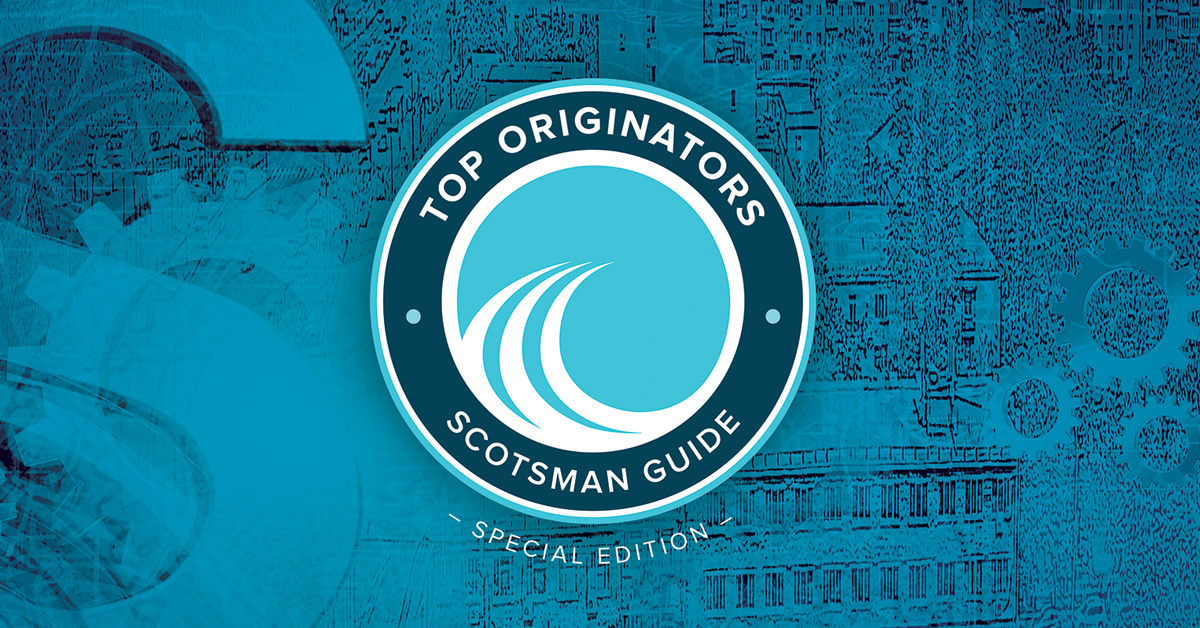Two years of unprecedented sales volume in the mortgage industry has come to an end. In particular, the tsunami of refinances has evaporated, but it’s not the end of days. Refinance numbers now resemble pre-pandemic numbers from late 2018 and early 2019, while cash-out refinances have grown in popularity in 2022.
Since refi volumes in 2020 and 2021 stayed below the record levels of 2003, and home values remain strong, most economists don’t expect a housing crash. But it’s undoubtedly difficult to come down from the peak, especially as mortgage jobs gained during the boom are being lost.
This month’s Top Originators rankings feature highlights the tireless work done by sales professionals at the peak of the home lending boom, in both the refinance and purchase markets. The rankings on the next several pages delve into Scotsman Guide’s Top Purchase Volume and Top Refinance Volume categories, each of which cover the top 100 originators who collectively closed tens of billions of dollars in these loan categories last year.
The 100 Top Refinance Volume originators closed $34.5 billion in refis alone last year. Thuan Nguyen of Loan Factory Inc. crossed the $2 billion refi threshold for the first time in Scotsman Guide history to close $2.1 billion across 5,633 loans. The No. 2 and No. 3 most productive refi originators, Shant Banosian and Ben Cohen of Guaranteed Rate, each set new personal records as well. Banosian closed $1.2 billion across 2,350 refinances while Cohen closed $945.2 million across 1,671 refis. Despite increased volumes from the top performers on this list, the aggregate figure for the Top Refinance Volume rankings dipped slightly from an astounding $37 billion in the 2020 production year.
The purchase mortgage market was on fire last year, which is reflected in the Top Purchase Volume list. The aggregate volume for these 100 originators soared from $20 billion in 2020 to $26.9 billion in 2021. Banosian, the No. 1 purchase loan originator, increased his volume by 38% in 2021 to close slightly more than $1 billion across 1,790 purchase loans. Banosian is the first originator in the history of Scotsman Guide’s rankings to cross the $1 billion purchase loan threshold.
He was followed by Tim Potempa, who closed $771.7 million across 1,406 purchase loans at Fairway Independent Mortgage Corp. before moving to OneTrust Home Loans. Rounding out the top five are Ben Cohen of Guaranteed Rate ($712 million), Mark Cohen of Cohen Financial Group ($644.2 million) and Danny Meier of Academy Mortgage Corp. ($560.7 million).
Next month, Scotsman Guide will feature its State Champions list — the top volume originator for each state and the final send-off for this year’s rankings. It feels a bit odd to celebrate last year’s massive wins at the tail end of a difficult year, but these hard-working originators earned their time in the spotlight.
As the mortgage industry grapples with the consequences of rising inflation, heightened interest rates and slowly rebounding housing supply, there is much uncertainty. Many mortgage professionals are just beginning to find their footing again. As we settle into a new normal, we wish the very best for all of our readers. Have a wonderful Thanksgiving and a great start to your holiday season. ●
Adjustable-rate loans rise in popularity

In a market with relatively high interest rates, today’s homebuyers are looking for ways to keep costs low and save money. Adjustable-rate mortgages (ARMs), which typically offer a lower rate for the first five to seven years of the term, are gaining popularity in this environment.
According to a recent report from Zillow, ARMs comprised 12.2% of all mortgage applications this past July, more than doubling their share from January 2022. Because immediate affordability is the main draw of an ARM, it’s often seen as a means for buyers who couldn’t otherwise afford it to break into homeownership. But Zillow’s data revealed that recent ARM applications came from buyers with higher incomes who were seeking homes with higher values and can afford a rate hike a few years down the line.
Borrowers who chose an ARM in 2021 had a median household income of $165,000 and made a typical downpayment of 23.6% on a property with a median value of $565,000. These were higher amounts than the overall borrower population, which had a median household income of $91,000 and typically put down 10% on a property with a median value of $325,000.
ARMs carry inherent risks, but the recent increases in income and downpayments suggest that the new generation of ARM buyers will be able to absorb the higher costs that come after the loan’s introductory period.
What do applicants do after being denied?

In 2020, 13% of all mortgage applications were denied, according to an August 2022 analysis of Home Mortgage Disclosure Act data by Freddie Mac. That’s about 650,000 denials. The analysis looked at the initial reasons for denial and the steps that these borrowers took to receive subsequent approval.
Borrowers who were subsequently approved for a mortgage were more likely to report clerical errors with simple fixes as their initial reason for denial. These borrowers often reported missing or incomplete documentation, or appraisal differences. Three in 10 borrowers reported that debt or credit issues were responsible for their initial denial. These borrowers, despite reporting attempts to improve their debt or credit situations, were less likely to be subsequently approved.
After the initial denial, both the subsequently approved and nonapproved groups reported working on their credit score and debt. But the subsequently approved group more frequently reported working to organize documentation, obtain preapproval, or gather additional funds for closing costs or downpayments.
For originators, it’s noteworthy that 78% of subsequently approved applicants said they reapplied with the same lender, while only 17% of nonapproved applicants expected to apply a third time with the same lender. This suggests that keeping good relationships with borrowers, and providing education and consultation after a denial, can help them achieve their financing goals.
Refinances plummet from 2020 peak

Refinance applications have dropped dramatically since the boom of 2020 and 2021. For the week ending Sept. 9, 2022, the dollar volume of refi applications tracked by Fannie Mae’s Refinance Application-Level Index were 85.6% below their third-quarter 2020 peak.
The index, which sources data from Fannie Mae’s automated Desktop Underwriter system, also noted a 78% year-over-year decline in dollar volume. “Refinance applications had been decreasing during the four weeks leading up to the (Labor Day) holiday as mortgage rates moved higher, keeping refinance application dollar volume at its lowest level since January 2019,” said Fannie Mae chief economist Doug Duncan.
While the decrease in refi applications has been dramatic this year, the figure recorded in early September was only 31.5% below the average refi application levels of 2010 to 2018. And the index was only 0.9% lower than the level recorded during a previous refi slowdown in Q4 2018. Historically low interest rates during the first two years of the COVID-19 pandemic powered the surge that saw the highest level of refinance volume since 2009.
Rate locks slide to less than half of 2021 levels

Mortgage interest rate-lock activity dropped by 57.1% year over year this past August, according to Black Knight’s Originations Market Monitor report. Rate locks were down 8.9% compared to one month earlier.
While the challenging refinance market is responsible for much of this decline, purchase locks also have declined, slowing by 28.2% year over year in August. The overall market mix in August was 82% purchase loans and 18% refis.
Among the nation’s 20 most populous metro areas, New York City proved the most popular in August with 3.9% of total lock volume. It was followed by Los Angeles, Washington, D.C., Dallas and Chicago. Notably, each of these five metros saw their lock volumes decrease from July, except for Los Angeles, which saw a 2.2% increase in lock activity.
Across the top 20 metros, the lowest average mortgage rates in August were found in the Washington, D.C., Austin and Boston metro areas. Borrowers in these metros locked in average rates of 5.183%, 5.251% and 5.261%, respectively. The highest average rates that month were in Miami (5.594%), Chicago (5.593%) and Los Angeles (5.456%).
Author
-

Hannah Darden is the former industry rankings editor at Scotsman Guide Inc.
View all posts






